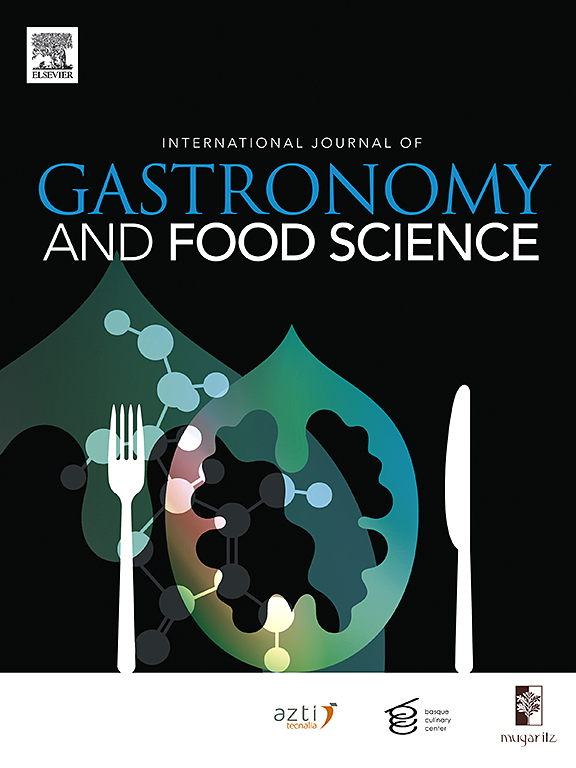Grains of wisdom: Insights into the minds of top chefs—A synthesis of expert interviews and literature
IF 3.2
2区 农林科学
Q2 FOOD SCIENCE & TECHNOLOGY
International Journal of Gastronomy and Food Science
Pub Date : 2025-03-28
DOI:10.1016/j.ijgfs.2025.101174
引用次数: 0
Abstract
This study explores Andean grains in contemporary gastronomy, identifying innovative applications and their socio-ecological implications. Through a mixed-methods approach, we conducted descriptive analysis of expert interviews with leading chefs across twelve countries and synthesized relevant scientific literature. Linguistic pattern analysis revealed regional variations in grain utilization, preferred companion ingredients, and preparation techniques.
Our research documented culinary innovations including Jordan Kahn's "Liquid Sable Cookie," Virgilio Martinez's quinoa leaf mille-feuille, Mugaritz's "Living Cannelloni," and Marsia Taha's quinoa butter. Additionally, the study conceptually reframes Andean grains through multiple functional lenses as: seeds, protein sources with Maillard reaction potential, fermentation bases for safer infant porridges, and structural components in gels and thickeners. Notably, grains could replace synthetic thickeners in professional kitchens, aligning with emerging research on the varied impacts of synthetic hydrocolloids on gut health. We discovered understudied varieties such as quinoa chullpi, which lacks representation in scientific literature, amaranth's unique ability to create sauces without skins, and grains' potential to transform into luxurious butter alternatives.
By documenting chefs as scientific storytellers, we demonstrate how they translate agricultural biodiversity into sensory experiences, bridging the scientific community with the public. Ultimately, the research emphasizes direct farmer-chef-consumer relationships in supporting grain diversity, addressing nutrition challenges, enhancing climate resilience, and preserving cultural and agricultural heritage.
智慧的颗粒:洞察顶级厨师的想法-专家访谈和文献的综合
本研究探讨安第斯谷物在当代美食,确定创新的应用和他们的社会生态影响。通过混合方法,我们对12个国家的顶级厨师的专家访谈进行了描述性分析,并综合了相关的科学文献。语言模式分析揭示了粮食利用、首选辅料和制备技术的区域差异。我们的研究记录了烹饪方面的创新,包括乔丹·卡恩的“液态紫苏饼干”、维吉里奥·马丁内斯的藜麦叶千层杂碎、穆加里茨的“活意式卷饼”和玛西亚·塔哈的藜麦黄油。此外,该研究通过多个功能透镜从概念上重构了安第斯谷物:种子、具有美拉德反应电位的蛋白质来源、更安全的婴儿粥的发酵基础以及凝胶和增稠剂中的结构成分。值得注意的是,谷物可以取代专业厨房中的合成增稠剂,这与有关合成水胶体对肠道健康的各种影响的新兴研究相一致。我们发现了一些未被充分研究的品种,比如在科学文献中缺乏代表性的藜麦(quinoa chullpi)、苋菜(amaranth)制作无皮酱汁的独特能力,以及谷物转化为奢侈黄油替代品的潜力。通过记录厨师作为科学讲故事的人,我们展示了他们如何将农业生物多样性转化为感官体验,在科学界与公众之间架起了一座桥梁。最后,该研究强调在支持粮食多样性、应对营养挑战、增强气候适应能力以及保护文化和农业遗产方面,农民-厨师-消费者之间的直接关系。
本文章由计算机程序翻译,如有差异,请以英文原文为准。
求助全文
约1分钟内获得全文
求助全文
来源期刊

International Journal of Gastronomy and Food Science
Social Sciences-Cultural Studies
CiteScore
5.30
自引率
10.50%
发文量
170
审稿时长
45 days
期刊介绍:
International Journal of Gastronomy and Food Science is a peer-reviewed journal that explicitly focuses on the interface of food science and gastronomy. Articles focusing only on food science will not be considered. This journal equally encourages both scientists and chefs to publish original scientific papers, review articles and original culinary works. We seek articles with clear evidence of this interaction. From a scientific perspective, this publication aims to become the home for research from the whole community of food science and gastronomy.
IJGFS explores all aspects related to the growing field of the interaction of gastronomy and food science, in areas such as food chemistry, food technology and culinary techniques, food microbiology, genetics, sensory science, neuroscience, psychology, culinary concepts, culinary trends, and gastronomic experience (all the elements that contribute to the appreciation and enjoyment of the meal. Also relevant is research on science-based educational programs in gastronomy, anthropology, gastronomic history and food sociology. All these areas of knowledge are crucial to gastronomy, as they contribute to a better understanding of this broad term and its practical implications for science and society.
 求助内容:
求助内容: 应助结果提醒方式:
应助结果提醒方式:


